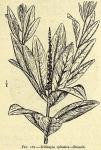304. Stillingia.

 The dried root of Stillin'gia sylvatica Linné.
The dried root of Stillin'gia sylvatica Linné.
BOTANICAL CHARACTERISTICS.—Stem herbaceous, 1 to 3 feet high. Leaves alternate, nearly sessile, oblong-lanceolate, finely serrate. Flowers monoecious; in a terminal spike (the fertile flowers at the base), with saucer-shaped glands at the base of each; stamens 2 or 3; style 1; stigmas 3. Capsule 3-celled, 3-lobed, 3-seeded.
HABITAT.—United States, from Virginia to Florida, in sandy soil.
DESCRIPTION OF DRUG.—A subcylindrical root, 300 mm, (1 ft.) long, 25 to 50 mm. (1 to 2 in.) or more thick, slightly tapering and sparingly branched; compact; fracture fibrous; odor distinct, peculiar, stronger and disagreeable when fresh; taste bitterish and pungent, persistently acrid.
The color of the exterior surface varies considerably, due, probably, to the varied character of the soils in which the plants grow. Roughly speaking, the roots would thus be classified into light and dark stillingias. By the accidental removal of their outer bark the pinkish inner bark is exposed. Transversely the woody cortex is seen to occupy about one-half of the diameter of the root. Around this is disposed the thick bark containing numerous bast fibers separately imbedded in the parenchyma. The cambium line is composed of distinctly marked flat cells. Woody center radiate, through which numerous tracheids, arranged in f our or five radiating rows that are quite regular in their disposition.
Powder.—Characteristic elements: See Part iv, Chap. I, B.
CONSTITUENTS.—The active principle has not yet been determined; it is probably a volatile principle, as old roots are nearly inert. An acrid resin (sylvacrol, soluble in alcohol and chloroform, insoluble in benzene), volatile oil, fixed oil, resin, starch, tannin, and gum have been separated. The so-called oil of stillingia, as found in the market, is intended to be the ethereal extract, but sometimes possesses very little of the persistent acrimony of the root. Ash, not to exceed 5 per cent.
ACTION AND USES.—An efficient alterative and antisyphilitic, usually given in combination, often with sarsaparilla, but more generally in the compound syrup of stillingia. Dose: 15 to 30 gr. (1 to 2 Gm.).
OFFICIAL PREPARATION.
Fluidextractum Stillingiae, Dose: 15 to 20 drops (1 to 2 Mils).

